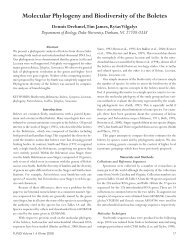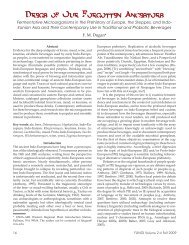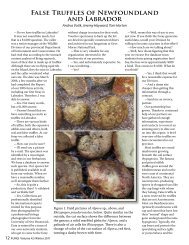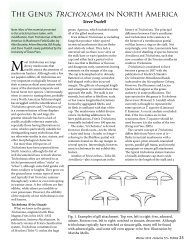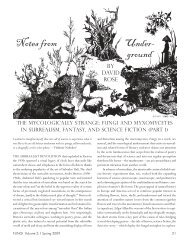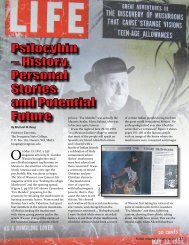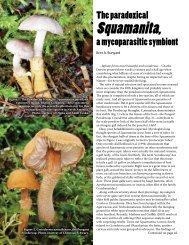by Helmut Brandl
by Helmut Brandl
by Helmut Brandl
Create successful ePaper yourself
Turn your PDF publications into a flip-book with our unique Google optimized e-Paper software.
times of superstition, luminescent wood<br />
had a great influence on the mind, and<br />
many suspected spook and magic when<br />
confronted with it in the dark.”]<br />
Figure 1 shows a piece of wood which<br />
emits light. The light is easily visible in<br />
a very dark room after adaptation of<br />
the eyes to the darkness for about five<br />
Figure 1. Luminescent wood,<br />
photographed in daylight (top)<br />
and in the dark (bottom) with an<br />
exposure time of 15 sec.<br />
minutes.<br />
Originally, the reason for the<br />
light emission was attributed to the<br />
rotting of wood based on oxidation<br />
processes (Heinrich, 1815). A kind of<br />
“self-combustion” was assumed or a<br />
decomposition of water concomitant<br />
to a slow combustion of hydrogen<br />
released (“ein Vegetiren im Feuchten,<br />
ein Zersetzen des Wassers, ein damit<br />
gleichzeitiges, sanftes Verbrennen des<br />
frey werdenden Wasserstoffgases in<br />
der unterirdischen Atmosphäre zu<br />
erkennen” from Nees von Esenbeck,<br />
6 FUNGI Volume 4:2 Spring 2011<br />
1823). [Translation: “A rotting under<br />
damp conditions, a decomposition of<br />
water, a gentle combustion of hydrogen<br />
gas released in the subterrestrial<br />
atmosphere.”]<br />
The cause, however, was in the<br />
infection of the wood <strong>by</strong> fungi, mainly<br />
Armillaria mellea (honey mushroom)<br />
(Molisch, 1912). Rhizomorphs of<br />
A. mellea (thick tubular “root-like”<br />
morphological structures) emit greenishwhite<br />
light whereas the fruit body is<br />
non-luminescent: “Das Licht wird<br />
überall gleich beschrieben als ruhig und<br />
gleichförmig anhaltend, bläulichgrün bis<br />
schön grün” (Heller, 1853) or “The light<br />
is everywhere described as quiet and<br />
uniform, bluish-green to green.”<br />
Both Conrad Gessner and Francis<br />
Bacon (philosopher and statesman)<br />
recognized that the light emission from<br />
wood was not related to heat radiation.<br />
Bacon wrote (Bacon, 1620):<br />
“Omne ignitum ita ut vertatur in<br />
ruborem igneum etiam sine flamma<br />
perpetuo calidum est;[…] sed quod<br />
in proximo est videtur esse lignum<br />
putre, quod splendet noctu neque<br />
tamen deprehenditur calidum, […].”<br />
[Translation: “All things which are lit will<br />
end up in fiery redness and are always<br />
hot even without flames, (…) but what<br />
comes nearest seems to be rotten wood,<br />
which shines <strong>by</strong> night and yet is not<br />
found to be hot, (…).”]<br />
Today it is known that the light<br />
originates from a metabolic reaction<br />
of the fungus where electrons are<br />
transferred to an acceptor (luciferin)<br />
which is cleaved <strong>by</strong> an enzyme<br />
(luciferase) in the presence of oxygen.<br />
This results in the formation of an<br />
electronically excited state of the<br />
luciferin and the subsequent emission<br />
of light with a maximum wavelength of<br />
approximately 525 nm during return to<br />
the ground state (Airth and McElroy,<br />
1959; Hastings, 1996). An example<br />
of a mushroom (Mycena illuminans)<br />
exhibiting light emission from stems and<br />
fruit bodies is shown in Figure 2.<br />
In a funny story, Friedrich Ludwig<br />
reported how luminous wood was picked<br />
up from the ground to lighten the route<br />
when returning home close to midnight<br />
from a trip trough the dark forest<br />
(Ludwig, 1901):<br />
“An der Strasse, die von Greiz nach<br />
dem idyllisch gelegenen Ida-Waldhaus<br />
führt, waren an einem Waldschlag,<br />
der von hallimaschkranken Fichten<br />
bestanden war, Wurzelstöcke ausgerodet<br />
und in Klaftern aufgeschichtet worden.<br />
Da das von dem Hallimaschpilz befallene<br />
Holz regelmässig leuchtet, bieten<br />
derartige Schlage in finsterer Nacht einen<br />
prächtigen Anblick und die Passanten<br />
ziehen öfter mit den leuchtenden<br />
Holzstücken vom Waldhaus nach Greiz<br />
heimwärts, was dem Beschauer wie ein<br />
gespenstischer Laternenzug erscheint.”<br />
[Translation: “On the road leading from<br />
Greiz (town in Thuringia, Germany) to<br />
idyllic Ida-Waldhaus, wood and roots<br />
from Armillaria-infected pine trees<br />
have been stacked. Because the wood<br />
emits light continuously, these stacks<br />
present a gorgeous sight in the dark and<br />
pedestrians often walk home with the<br />
luminescent wood, giving the impression<br />
of a spooky parade.”]<br />
The Austrian physician and chemist<br />
Johann Florian Heller addressed the early<br />
descriptions <strong>by</strong> Aristotle and Pliny and<br />
related them to the occurrence of fungi<br />
in mining locations (Heller, 1853):<br />
“Eines der interessantesten<br />
altliterarischen Daten, welches ich<br />
bisher auffinden konnte und unter<br />
den alten Autoren von wirklichem<br />
Werthe erscheint, ist die Mittheilung<br />
von Aristoteles (de anima Lit. II. Cap.<br />
VII.), dass nämlich manche Schwämme<br />
im Finstern einen leuchtenden<br />
Schein verbreiten sollen. Spätere<br />
Naturforscher läugneten es, bis man<br />
wieder bei Grubenbauten durch die<br />
Bergleute die schon von Aristoteles<br />
gemachte Beobachtung bestättigt fand.“<br />
[Translation: One of the most interesting<br />
facts in the ancient literature is the<br />
remark of Aristotle (de anima Lit. II. Cap.<br />
VII.) that many sponges emit light in the<br />
dark. Later however, naturalists denied



